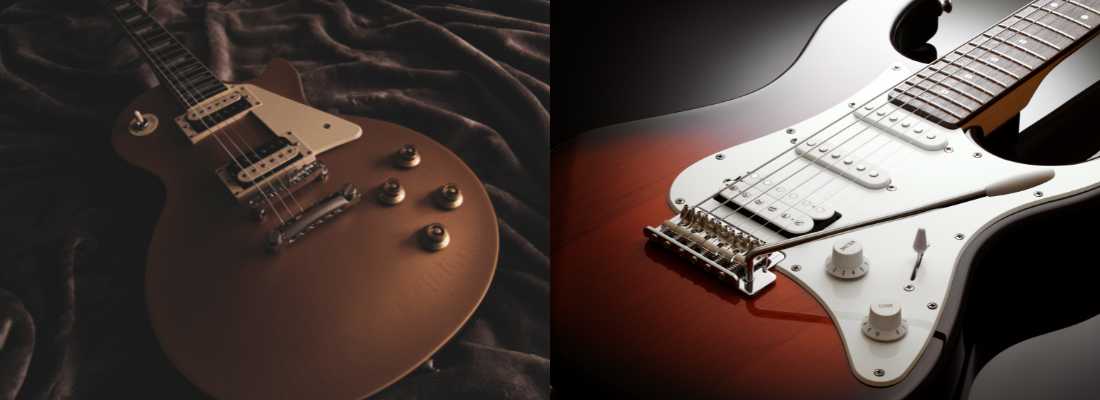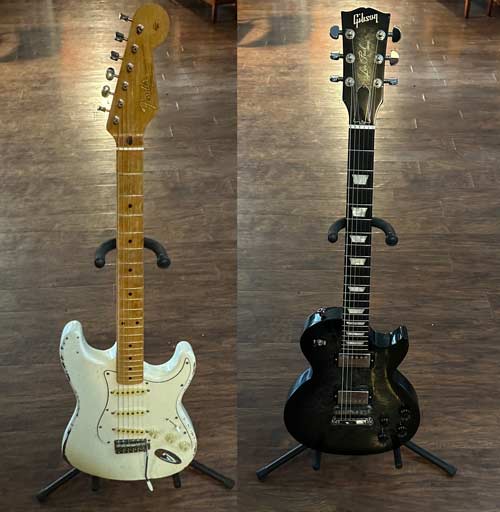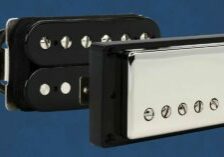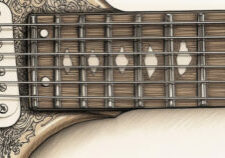Comparing a Stratocaster vs. Les Paul is a fun discussion because this war has no losers. The Fender Stratocaster and Gibson Les Paul are two of the world’s most iconic and beloved electric guitars. These two instruments have been used on stages and in recording studios for 70+ years, each with its own unique sound and feel.
I suppose battle isn’t the best word, as both guitars don’t fight each other. It’s like comparing vanilla vs. chocolate ice cream – both are great and each individual has their preference in flavor. Below I’ll do my best to explain the pros and cons of each, and why you might choose one over the other.
Key Takeaways
- Sound and Feel: Les Paul has fat-sounding humbuckers and a warm, rich tone, while Stratocaster has glassy-sounding single coils and a bright, balanced tone.
- Price Difference: Les Paul is generally 40-50% more expensive than Stratocaster.
- Headstock Design: Les Paul has a weak design prone to snapping off, while Stratocaster has a sturdier design.
- Neck Differences: Traditionally, the Stratocaster has a more curved fingerboard and a slimmer neck, while Les Paul has a flatter fingerboard and a thicker neck.
- The Stratocasters design lends itself to making quick changes to pickup configuration.
Configuration of The Les Paul & Strat
It’s worth noting that both of these guitars can be configured with any combination of bridge, tuners and pickups. But for this article, we’ll talk about the common configuration of standard models of these guitars.
Here is a table that shows the major differences between both guitars
| Feature | Les Paul | Fender Strat |
|---|---|---|
| Pickups | Two hubuckers | Three Single Coils |
| Scale Length | 24 3/4 | 25 1/2 |
| Tone Controls | 4 for tone and volume | 3 for tone and volume |
| Pickup Selections | 2 Selections | 5 Selections |
| Body Wood | Mahogony with Maple Top | Alder or Ash |
| Bridge | Tune-O-Matic Fixed | Tremolo with Whammy Bar |
| Neck Wood | Mahogany | Maple |
Sound and Feel
These guitars generally sound quite different. While both can be used for any guitar, some genres of music lend themselves better to each guitar. For example, Fenders are known for their bluesy and clean sounds. At the same time, the humbucker of the Les Paul is known for creating a gritty distortion sound with incredible clarity. Also, the Strat with single coils doesn’t lend itself well to high gain or heavy metal, so you rarely see guitarists use a Strat for this type of music.
Gibson Les Paul Sound
The Les Paul’s sound can be described as warm and luscious. Its low end has an incredible weight and presence. The midrange is smooth and articulate, allowing for expressive and nuanced playing. And the high end is crisp and clear, adding a sparkling brilliance to each note.
When played clean, the Gibson Les Paul emits a smooth and velvety sound, perfect for jazz or blues. Its sustain is remarkable, allowing for notes to ring out beautifully and effortlessly, creating a sense of infinite space and depth.
However, when the Gibson Les Paul is unleashed with overdrive or distortion, it transforms into a beast of unparalleled power and aggression. Its sound becomes thick and monstrous, with a raw energy that ignites the senses. The chords become massive and explosive while the solos soar with intensity. It is a weapon in the hands of a skilled guitarist.
The sound of a Gibson Les Paul is not only a testament to the craftsmanship and quality of the instrument itself, but also to the countless musicians who have wielded it to create timeless and iconic music. From the soaring solos of Jimmy Page to the searing riffs of Slash, the Gibson Les Paul has become a symbol of rock ‘n’ roll and a staple in the arsenal of countless guitarists.
Fender Stratocaster Sounds
The Strat resonates with a rich, well-balanced tone that effortlessly cuts through any mix. The three single-coil pickups, strategically positioned along the body, capture every nuance and intricacy of the player’s touch, delivering a wide range of tonal possibilities that cater to any musical genre.
The bridge pickup of the Stratocaster delivers a biting, treble-heavy tone that is perfect for searing lead work and blistering solo. The the neck pickup provides a warm, smooth sound that is ideal for soulful blues and jazz. The middle pickup offers a sweet, glassy tone that adds depth and dimension to chords and rhythm playing. This trifecta of pickups can be blended and combined using the five-way pickup selector switch, allowing players to sculpt their desired sonic landscape with precision and finesse.
The guitar’s unique wiring, hardware, and design elements work harmoniously to create a sonic experience that is truly unparalleled. Its synchronized tremolo system allows for expressive pitch manipulation, adding a touch of shimmering vibrato or dramatic dive bombs to the player’s arsenal.
From the scorching blues solos of Stevie Ray Vaughan to the soaring rock anthems of Jimi Hendrix, the Stratocaster has been the catalyst for countless musical revolutions. Its sound has become ingrained in the fabric of popular music, a testament to its enduring legacy and the endless possibilities it offers to those who wield it.
Les Paul and Stratocaster Comparison
This video below includes 2 of my favorite guitar channels on YouTube. Rhett Shull and Rick Beato. These show you a comparison of both the strat and the Les Paul.
Price Difference
Les Paul guitars are generally 30-50% more expensive than Stratocasters. This price difference is due to several factors.
Firstly, the craftsmanship and heritage associated with Gibson contribute to the higher price of Les Paul guitars. Gibson has a long-standing reputation for producing high-quality instruments, and this reputation comes at a premium.
Secondly, Les Paul guitars are known for their use of high-quality materials. From the wood used for the body to the hardware and electronics, Gibson ensures that every component of their guitars is top-notch. This attention to detail adds to the overall cost of the instrument.
A Les Paul Standard, for example, can cost around $3,000 new while an American Professional Stratocaster is priced around $1,700.
There are more affordable options of each guitar. The Les Paul has different models that are much cheaper. Their lowest priced Studio model, has less appointments but cost only $1699.0. Fender has a version of the The Stratocaster that is made in Mexico for $899.00. It will have a different bridge, tuners and pickups.

Headstock Design
When comparing the headstock design, you’ll notice that the Stratocaster has a sturdier, flatter design compared to the Les Paul. The Stratocaster’s recessed headstock requires a string tree on the E and B strings, ensuring better string tension and stability.
On the other hand, the Les Paul’s headstock has a weak design that is prone to snapping off, and it has a 17-degree back angle which can potentially cause tuning problems. Yes, breaking headstocks on a Les Paul is certainly a thing. So you just have to be careful.
Neck Differences
When comparing the neck differences between the Stratocaster and the Les Paul, several distinct characteristics stand out.
Firstly, the Stratocaster features a more curved fingerboard and a slimmer neck. And Strat necks usually come with a more curved fingerboard. Strats often come with a 9.5′ radius, which some people like. It enables easier string bending and allows for intricate techniques. The slimmer neck profile of the Stratocaster provides a fast and agile feel, making it an excellent choice for players who prefer a sleeker neck.
On the other hand, the Les Paul boasts a flatter fingerboard with a 12′ radius. This flat fingerboard offers a different playing experience, allowing for easier string bending with less effort. Additionally, the Les Paul’s thicker neck, available in 50s or 60s style, provides a more substantial feel. This thicker neck contributes to added stability and sustain, enhancing the overall playing experience.
Fingerboard Binding
The fingerboard binding on the Gibson Les Paul adds a touch of elegance and comfort, like a satin ribbon gently wrapped around the edge of the fingerboard. Not only does it enhance the visual appeal of the guitar, but it also improves the playing experience.
The binding on the sides of the fingerboard provides a smooth and comfortable surface for your fingers to glide across, reducing any potential discomfort during long playing sessions. Stratocasters do not come with fingerboard binding.
Scale Length
The scale length refers to the length of the vibrating portion of the strings from the nut to the bridge. It plays a significant role in determining the overall feel and playability of the instrument.
In the case of the Stratocaster and Les Paul, there is a difference in scale length. The Stratocaster has a longer scale length of 25.5 inches, while the Les Paul has a shorter scale length of 24.75 inches.
The longer scale length of the Stratocaster contributes to its brighter sound and facilitates more tension in the strings, resulting in a snappier feel. On the other hand, the shorter scale length of the Les Paul provides a slightly warmer and rounder tone with a looser feel.
Neck Joint Style
The Fender Stratocaster and the Gibson Les Paul have distinct neck joint designs that greatly impact their playability and tone. The Stratocaster features a bolt-on neck joint, which allows for easier neck adjustments and replacement. This design contributes to the guitar’s bright and balanced tone, as well as its resonance.
On the other hand, the Les Paul has a glued-in neck joint, providing better sustain and a more solid feel. This construction enhances the Les Paul’s warm and rich tone.
Body Shape and Weight
When comparing the body shape and weight of these guitars, you’ll notice significant differences. The Les Paul features a thicker and heavier body, providing more sustain due to its thicker body and glued-in neck.
On the other hand, the Stratocaster has a thinner and lighter body, offering more resonance due to its thinner body and bolt-on neck. These differences in body shape and weight contribute to the overall feel and sound of the guitars.
It’s worth noting that modern Les Paul guitars can come with bodies that include weight reduction, where they drill out some of the wood under the top.
Bridge Design
The Les Paul features a Tune-o-matic bridge, which fixed bridge that provides excellent intonation and string stability. It allows for precise adjustment of each string’s height and length, ensuring accurate tuning and a solid feel.
On the other hand, the Stratocaster is equipped with a tremolo bridge, which enables smooth and controlled pitch variations. This iconic design allows players to add subtle vibrato or create dramatic dive-bombing effects.
The bridge design is an essential consideration for players seeking specific tonal characteristics and performance capabilities. It’s important to choose the one that aligns with your musical preferences and playing style.
Body Wood
Choose the guitar that resonates with your style and preferences by considering the body wood. The body wood helps shape the overall tone and resonance of the instrument.
The Les Paul uses a mahogany body with a maple top. The Stratocaster uses either an Alder or an Ash body. It often depends on the year and how difficult it was to source wood.
Finish Options
When it comes to finish options, Gibson Les Paul offers a wider variety, allowing you to choose from a range of colors and finishes, including transparent colors, bursts, solid colors, and even custom finishes.
On the other hand, Fender Stratocaster tends to offer more classic finishes, sticking to the traditional sunburst, solid colors, and vintage-inspired looks. Most strat models come in opaque solid colors.
Also, Les Pauls always use nitrocellulose (nitro) lacquer to finish their guitar. Stratocasters were once finished in nitro, but in the late 1960’s they started moving to polyurethane finishes for the improved durability.
Resale Value
If you’re looking to invest in a high-quality guitar that holds its value well over time, resale value is an important factor to consider.
When comparing the Stratocaster and Les Paul, it’s worth noting that Les Paul guitars tend to hold their value better than Strats. This is due to the reputation and heritage of Gibson as a brand, as well as the craftsmanship and attention to detail that goes into making each Les Paul.
While Fender Strats also have a strong resale value, Les Pauls have a certain allure and desirability that keeps their prices high in the used market.
Les Paul vs. Stratocaster: Conclusion

These two iconic instruments are awesome. They are so good and so unique that many guitarists, like myself, have one or more of each. The photo to the left shows two of the guitars I own. I also own a few other Fender Stratocaster along with some strat clones made by other companies.
My first guitar was a 1991 Fender American strat, but I sold it and kept the relic Strat I built 2021. The Les Paul is a 2011 Limited Edition Studio Black/Silver Swirl.
In the end, it all comes down to personal preference. I enjoy grabbing the Strat and popping on the neck pickup to play some Hendrix. I also love cranking up the gain and playing some Guns N’ Roses on the Les Paul. I consider both necessities as long as I’m still paying guitar!





